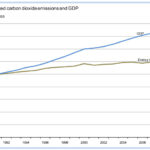Posts in the 'Energy + Climate Change' category
In Delhi, urban planner and architect Manit Rastogi has a plan to transform the city’s 350 kilometers of storm water drains – or nullahs – into a network of “landscaped passages for New Delhi’s pedestrians, cyclists and solar-powered rickshaws,” as ...

“This project marks a significant break with traditional thinking that regards transport as too hard to deal with when it comes to greenhouse gas reduction.” — Prof. John Whitelegg, co-author of “Towards a Zero Carbon Vision for UK Transport“ A new ...

Over the past year, we’ve written extensively about the new bus rapid transit (BRT) system in Ahmedabad, India, called Janmarg BRT. The system — India’s first full BRT — was a game-changer in India in the sphere of urban transit ...

Within five to ten years, Oakland, Calif., has the potential to become a model of urban revitalization and sustainable livability. It may sound a bit paradoxical — but it’s possible. The name Oakland still too often conjures images of a ...

This season, we’ve been following Mumbai through the monsoon, looking at how monsoon season can ravage transportation systems and batter infrastructure, putting people’s lives and livelihoods in jeopardy. Now, a new study in Nature Geoscience describes how climate change from ...

On the hottest days of summer, AC-less city-folk can be found sticking their heads in refrigerators and sinks full of ice water, putting their faces in front of fans — or open fire hydrants — and guzzling ice cold beverages ...

“As the sludge choking the Gulf of Mexico shows, nothing is easy when it comes to oil. Not even the price. In fact, especially not the price.” – Ezra Klein, in the Washington Post Disturbing footage of oil spewing into the ...

Welcome to another installment of “What’s Schipper Saying?”, a collection of comments about sustainable transport, cities and fuel efficiency made by Lee Schipper, a senior research engineer at the Precourt Energy Efficiency Center of Stanford University and the founder of ...

The British newspaper the Guardian has published an interactive tool on its website that allows the user to simulate different policies at the national scale for reducing the UK’s carbon footprint. The user can opt for any number of policies, ...

Raising the price of gas to $7 per gallon may be necessary to meet the U.S. Environmental Protection Agency’s 2020 targets for cutting greenhouse gas emissions by 14 percent, says a new report from Harvard’s Belfer Center for Science and ...

Following up on our post about the treatment of the transport sector in countries’ post-Copenhagen plans, we’d like to point you to the analysis of developing countries’ Nationally Appropriate Mitigation Actions (NAMAs) completed by the Bridging the Gap Initiative. The ...

The first major piece of follow-up to the Copenhagen Accord took place Monday: the countries responsible for the bulk of climate-altering pollution formally submitted emission reduction plans, meeting the agreement’s Jan. 31 deadline. Fifty-five developed and developing countries submitted plans ...

Copenhagen’s COP-15 meeting came and went, and now, it’s down to the details of figuring out how to implement the commitments and plans for action. A new draft report about the applicability of post-2012 instruments to the transport sector was ...

I just returned from a Brookings Institution event on infrastructure investment, economic growth, and jobs. The talk included a great cast of academics, politicians, transportation officials and journalists. This came just two days after President Obama’s high-profile jobs speech at ...

The World Resources Institute yesterday released a new English-language Web site, ChinaFAQs.org, dedicated to answering questions about climate change and energy in China. The easy-to-navigate online resource so far lists the bios and contact information of 26 experts, including nonprofit ...

Page 35 of 39« First...1020...343536...Last »






















